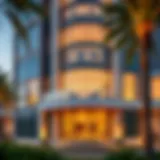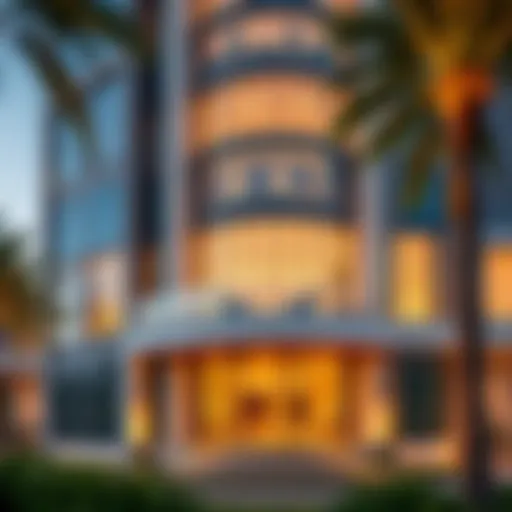Explore the 64 Bus Route in Dubai: A Complete Guide
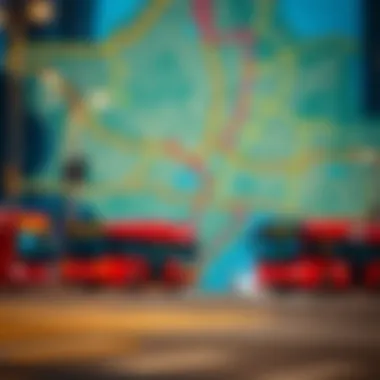
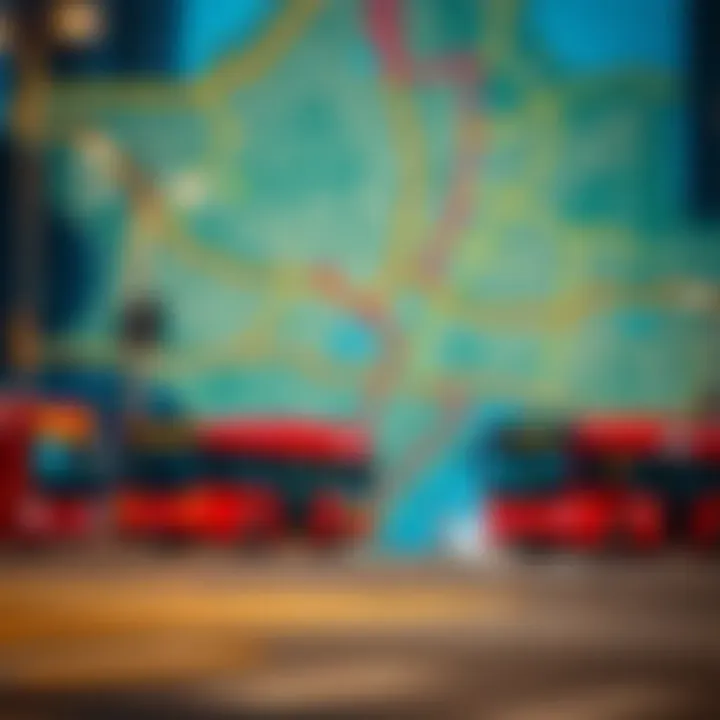
Intro
The 64 bus route in Dubai is more than just a means of getting from point A to point B; it's a crucial artery in the city's extensive public transportation system. It's designed not only for the daily commuter but also for tourists eager to explore the neighborhoods that make up this vibrant metropolis. This guide aims to walk you through the key features of the 64 bus route, the neighborhoods it passes through, and its implications on the local real estate market. Each stop along the way presents more than just a destination—it reveals insight into trends, demographics, and investment opportunities that can significantly impact both locals and visitors.
Property Trends in Dubai
Understanding the property landscape in Dubai, especially in relation to the 64 bus route, is a wise move for investors and homeowners alike. The areas served by this route have seen considerable changes in recent years, and some neighborhoods are emerging as real hotspots, attracting interest from various sectors of the market.
Emerging Neighborhoods and Hotspots
Several neighborhoods along the 64 bus route are becoming the talk of the town. They show promise for high returns and residential appeal. For instance, Al Quoz has transitioned from a primarily industrial zone to a cultural and residential hub, with art galleries and cafes popping up like mushrooms after rain. Similarly, Al Safa is not just another stop; it's an area where modern brownstones meet vibrant community spaces, making it attractive to young professionals and families alike.
- Al Quoz: Known for its art scene and growing residential communities.
- Al Safa: Offers a balance of modern living and cultural heritage.
- Jumeirah Village Circle: Another hotspot with affordable options and a family-friendly vibe.
Market Analysis and Future Predictions
Analyzing the trends within these neighborhoods near the 64 bus route reveals potential for further growth. As public transport expands, so does the attractiveness of the surrounding real estate. According to statistics from the Dubai Land Department, areas that are well-served by public transportation are witnessing property value fluctuations aligned with developments in transport infrastructure.
Investors should note that price per square foot in these emerging neighborhoods is competitive, providing opportunities for those willing to dive deeper into the market.
"Public transit accessibility is a key driver for property values; as cities grow, those with well-planned transport systems witness enhanced real estate appeal."
Investment Opportunities
For investors mindful of ROI, the 64 bus route opens the door to various property types that maximize potential gains. Targeting the right type of investment is critical in a rapidly changing market like Dubai.
High-ROI Property Types
Investors might consider:
- Apartments: With single and multi-bedroom options, especially with new developments in the pipeline.
- Commercial Spaces: Locations near bus stops serve as excellent venues for retail, catering to the foot traffic from commuters.
- Mixed-use Developments: These provide vibrancy and variety, often drawing in crowds at various times of the day.
Financing and Mortgage Options
For those looking to finance their investment, various mortgage options are available through local banks and financial institutions. It's worth checking out institutions like Emirates NBD or ADCB for their tailored mortgage plans, especially those that accommodate first-time buyers.
When seeking to invest in properties along the 64 bus route, staying informed about current interest rates and financing options can significantly enhance the overall investment strategy.
Ultimately, delving into the depths of the 64 bus route reveals not just a pathway through Dubai, but also a glimpse into the future of its neighborhoods and property markets. Investors and homeowners alike have much to gain from this route, one stop at a time.
Prelude to Dubai’s Public Transportation System
When you step into the ever-bustling metropolis of Dubai, it's hard to ignore the efficient public transportation system that hums quietly beneath the surface of its glimmering skyscrapers. This network is not merely a means to get from one place to another; it's a lifeline that facilitates daily commutes, encourages tourism, and supports the economy. Understanding this system, particularly the bus services, is essential for anyone looking to navigate the city effectively.
Overview of Bus Services
Dubai's bus services form the backbone of its public transportation system. With over 1,400 buses operating across various routes, these vehicles provide a reliable and cost-effective means of travel. The buses are spread out in a manner that connects different neighborhoods and key commercial districts, thereby playing a vital role in reducing the reliance on private vehicles. In fact, the Road and Transport Authority (RTA) estimates that bus ridership reaches millions annually, indicating the service's importance to the daily lives of both residents and visitors.
The buses, often equipped with air conditioning and comfortable seating, cater to the diverse demographics present in the city. For example, the 64 Bus Route is well-regarded for linking important residential areas with commercial hubs. It's designed to serve various customers—be they locals heading to work or tourists seeking to explore the rich culture that Dubai has to offer.
"A well-functioning public transport system not only eases daily travel but also reduces the overall congestion on the roads, benefitting everyone in the city."
Integration with Other Modes of Transport
Another noteworthy aspect of Dubai's public transportation system is its seamless integration with other modes of transport. The suburban metro lines and the water taxis complement the bus services, ensuring that passengers have multiple options when planning their journeys. For example, commuters can easily transfer from a bus at any of several designated stations to the Dubai Metro, which zips across the city’s skyline in no time. This integration is vital in providing an efficient travel experience that minimizes waiting times.
In addition, smart technology plays a significant role in this intricate network. Apps and online tools allow commuters to check schedules, track buses in real-time, and plan their journeys conveniently. This means that whether you're a first-time visitor or a long-time resident, navigating the public transportation system becomes a straightforward task.
For investors, developers, and urban planners, the effectiveness of Dubai’s public transport system presents numerous opportunities. Understanding how these transport routes affect neighborhoods can provide vital insights into potential developments and property investments. The more connected an area is via public transit, the more attractive it becomes for buyers, making transport a critical consideration in real estate ventures.
Understanding the Bus Route
The 64 bus route serves as a vital artery within Dubai's extensive public transport system, connecting various neighborhoods and key landmarks. Understanding this route is essential, whether you're a local commuter or a visiting tourist. The route not only facilitates daily travel but also unveils the geographical and socio-economic dynamics of the communities it touches. Through this section, we will delve into its historical context, route specifics, and the significant stops that help paint a complete picture of the 64 bus route's significance.
Historical Context
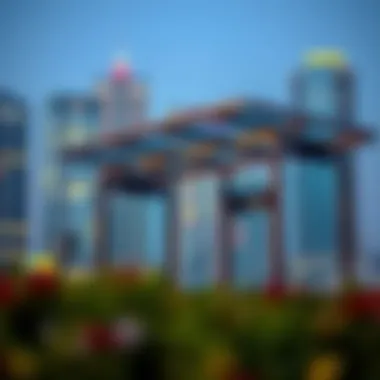
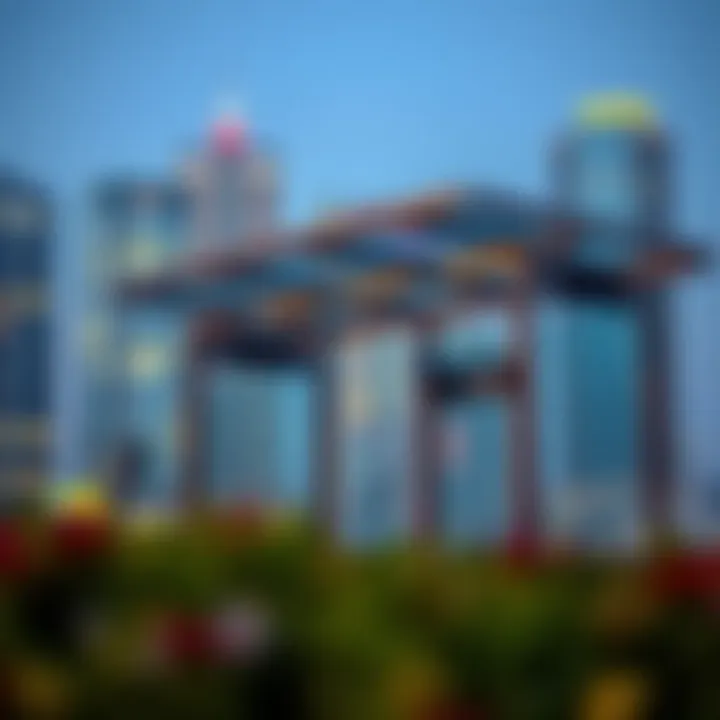
The 64 bus route isn't just a means for getting from point A to point B; it holds a history that reflects the growth and development of Dubai itself. Established in a period when Dubai was redefining its identity as a global hub, the bus route has evolved in response to the city's ever-changing demands. Early in its inception, the bus service was sparse, primarily catering to less populated areas. However, as urban development surged, so did the service.
It’s interesting to note that the introduction of the 64 bus route coincided with major infrastructural projects, such as the expansion of commercial districts and residential neighborhoods. This historical interplay illustrates how public transport can be a catalyst for urbanization. In a city like Dubai, where investment in infrastructure is robust, this bus route symbolizes connectivity and progress—ensuring that no neighborhood is left isolated in the wake of rapid change.
Route Specifications
As you ride along the 64 bus route, you’ll find a meticulously crafted path that maximizes efficiency and accessibility. Spanning several kilometers, the route is designed to accommodate both peak and off-peak traffic.
Key specifications include:
- Length of Route: Approximately 15 kilometers
- Duration of Trip: Around 30 to 45 minutes, depending on traffic conditions.
- Bus Frequency: Buses run every 10 to 15 minutes during peak hours, becoming less frequent during late nights.
Moreover, the buses used on this route are equipped with modern amenities, ensuring a smooth ride for passengers. Accessibility features, including ramps and designated seating, are also integrated into the design. This not only supports inclusivity but also enhances overall user experience.
Significant Stops Along the Route
Passengers traveling on the 64 bus will encounter various notable stops, each offering a glimpse into the vibrant neighborhoods and attractions that characterize Dubai. Here are some of the prominent stops along the way:
- Deira City Centre: A popular shopping destination that attracts both locals and tourists. Home to a wide range of retail outlets and eateries.
- Al Ghurair Centre: Another shopping hub which also features a cinema, providing entertainment options post shopping.
- Dubai Sports City: This area highlights Dubai's ambition in sports and recreation, offering facilities for various sports.
- Dubai Marina: Known for its scenic waterfront, this stop brings visitors to stunning views and vibrant nightlife.
These stops not only serve as connective points in the network but also hold cultural and commercial significance, allowing passengers an easy transition from one experience to another.
Overall, the 64 bus route enriches the journey through Dubai by linking essential neighborhoods and highlighting the city’s diverse offerings. In many ways, getting acquainted with this bus route opens a window to the soul of Dubai itself.
Key Neighborhoods Served by the Bus Route
The 64 Bus Route is more than just a line on a map; it's a lifeline connecting various vibrant neighborhoods throughout Dubai. Each area served by this bus route holds its own unique charm and significance, making it an indispensable part of the city's public transport landscape. Understanding these neighborhoods can help investors, homeowners, and city planners appreciate the interwoven dynamics of urban living and commerce in Dubai.
Residential Areas
The residential neighborhoods along the 64 Bus Route provide an eclectic mix of environments. For instance, Al Quoz offers a blend of urban life with art, as it houses numerous galleries and studios. This area attracts artists and young professionals, providing affordable housing options. The bus service is particularly beneficial here, enabling residents easy access to the bustling art scene without the hassle of driving or looking for parking.
Another noteworthy residential area is Jumeirah Village Circle (JVC). Characterized by its family-friendly ambiance and community-centric design, JVC is becoming increasingly popular among young families and expats. The 64 bus makes it easy for residents to reach nearby amenities, parks, and schools. This accessibility amplifies its attractiveness to potential homeowners and renters alike.
Commercial Spots
When it comes to commercial spots, the 64 Bus Route doesn't disappoint. Al Wasl Road, which runs adjacent to the line, is peppered with cafes, boutiques, and restaurants. This road is a bustling marketplace, serving as a commercial hub for both locals and tourists. The presence of the bus means easy commuting for small business owners and their customers, fostering greater interaction and spending in the area.
On another front, Mirdif City Centre is a standout. This shopping mall is a shopping paradise, featuring major brands, entertainment options, and eateries. The convenience of the bus service allows shoppers to hop on the bus and travel back and forth, further enhancing the appeal of this commercial hotspot. The integration of the 64 bus with such prime locations solidifies its role in supporting local businesses.
Cultural Landmarks
Cultural landmarks along the 64 Bus Route add another layer to the neighborhoods it connects. The Dubai Museum, located in the historic Al Fahidi Fort, is a must-visit for anyone eager to understand the emirate's rich past. The convenience of the bus route draws visitors, enriching the cultural experience for both tourists and locals alike. Its close proximity to the bus stops enhances accessibility to those interested in the heritage of Dubai.
Additionally, the Dubai Frame is another cultural icon accessible from the route. This architectural marvel offers breathtaking views of both old and new Dubai. The bus route ensures that curious onlookers can reach this spot without the need to grapple with the complexities of urban travel. With frequent stops and services, the 64 bus all but eliminates barriers between locals and these significant cultural touchstones.
In summary, the neighborhoods served by the 64 Bus Route exemplify the diverse tapestry of Dubai. From residential pockets that foster community to commercial avenues bustling with activity, each area enhances the overall experience for residents and visitors alike. Understanding this connectivity can be pivotal for investors looking to capitalize on the vibrant energy present in these neighborhoods.
Frequency and Schedule of the Bus Service
Understanding the frequency and schedule of the 64 bus service is crucial for anyone navigating Dubai’s intricate public transportation landscape. When considering public transport, timing often becomes the linchpin for efficiency. The 64 bus not only connects key neighborhoods but also does so with a schedule that supports the dynamics of a bustling urban environment.
Daily Schedules
The 64 bus service generally runs from early morning until late at night. Typically, buses depart every 30 minutes on weekdays, which ensures that riders do not have to wait too long before hopping on. This frequency can be especially advantageous for those commuting to work or attending appointments. Key timeframes to note:
- Weekdays:
- Weekends:
- First bus departs around 5:00 AM.
- Last bus departs around 11:30 PM.
- Slightly altered schedule with first bus at 6:00 AM and last at midnight.
While this routine accommodates the majority of the daily flow, it's advisable for passengers to check the local transport authority's app or website for real-time updates, especially during public holidays or events when schedules might shift. Factors such as traffic conditions will often dictate any necessary adjustments.
Peak vs. Off-Peak Hours
Another important aspect concerns the difference between peak and off-peak hours. During peak times, typically from 7:00 AM to 9:00 AM and 5:00 PM to 7:00 PM, buses can be packed with commuters. These are those moments when every seat is filled, and standing room becomes a premium. If you’re not one to relish the crowded bus experience, you might consider:
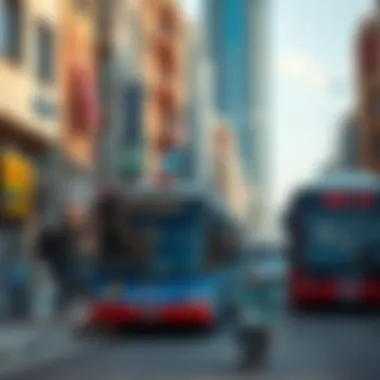

- Travelling before 7:00 AM or after 9:00 AM. This typically offers a quieter journey.
- Evening rides: They are often less crowded after 7:30 PM.
Off-peak hours, conversely, offer not only comfort but might also grant a better chance of reliable seat availability. Although, don’t let that fool you—it's still wise to keep an eye on bus timings during these hours as they can stretch out to 40 minutes if fewer people are using the service.
"Knowing when to ride the bus can enhance the experience, transforming a mundane journey into a comfortable ride."
In summary, being well-acquainted with the daily schedules and the ebb and flow of peak versus off-peak hours can significantly shape your experience while using the 64 bus route. It’s about being smart with time, a precious commodity in any city, especially one as dynamic as Dubai.
Benefits of Utilizing the Bus Route
The 64 bus route serves as a vital link in the extensive tapestry of Dubai's public transportation system. Beyond the convenience, there are numerous benefits tied to its operational presence that warrant a closer inspection. This route has implications not just for daily commuters but also for residents, investors, and urban planners alike. Understanding the advantages of utilizing this specific bus line can illuminate its broader significance in the urban landscape.
Cost-Effectiveness
One of the most appealing aspects of the 64 bus route is its cost-effectiveness. With public transport fares generally being lower compared to taxi rides or private vehicle expenses, this route allows riders to save on transportation costs. Consider this: a daily rider can expect to pay a fraction of what it would cost to drive, park, or hail a cab. For many residents and visitors, especially those on tight budgets, this makes commuting on the 64 a desirable option.
In an environment where prices can inflate faster than a hot air balloon, cost becomes a pivotal factor. The ability to travel across significant parts of Dubai while keeping one's expenses in check fosters a more financially sustainable lifestyle.
Reduced Traffic Congestion
Traffic congestion in urban spaces can feel like a never-ending battle. The efficiency of the 64 bus route plays a role in alleviating the incessant gridlock often experienced on Dubai's roads. By offering a reliable alternative to individual car travel, this bus service helps in reducing the overall number of vehicles on the road, which in turn eases congestion.
When public transport is prioritized, collective urban mobility flourishes, leading to smoother traffic flow and shorter travel times. On a busy workday morning, hopping on the 64 bus can be not only a time-saver but also a way to escape the frustration of stop-and-go driving.
Eco-Friendly Alternative
Living in an age increasingly defined by climate change and environmental challenges, choosing an eco-friendly mode of transport becomes paramount. The 64 bus route stands out as a greener alternative to personal automobiles. Utilizing public transport significantly decreases the carbon footprint per passenger compared to single-occupancy vehicles. This shift can create a substantial positive impact on the environment.
When more individuals opt for the bus over individual cars, the collective reduction in emissions adds up significantly. Embracing such options not only supports personal health in an urban milieu but also contributes to the broader goal of fostering sustainable cities.
"Public transport is not just a means to an end; it's a way to create sustainable urban living."
Impact of the Bus Route on Nearby Real Estate
The 64 Bus Route is more than just a means of transportation; it's a lifeline for the communities it serves. Understanding its impact on nearby real estate provides insights that are essential for both current homeowners and potential investors. The connection between public transport and property values is well-documented, and in a bustling city like Dubai, this relationship becomes even clearer.
The bus route opens avenues for those looking to buy or rent, making it an attractive option for families and young professionals. The accessibility offered by the 64 Bus Route can increase demand for properties located nearby, thereby influencing market dynamics.
Influence on Property Values
When examining the influence of the 64 Bus Route on property values, a few key aspects come to light:
- Proximity to Transport: Generally, properties located within walking distance of a bus stop enjoy higher demand. With easy access to public transport, buyers often see these homes as more desirable. As an example, areas like Al Quoz, which benefit from the 64 Bus Route, have witnessed a steady increase in property values due to their connectivity.
- Urban Development: The bus route serves as a catalyst for urban development. New commercial and residential projects sprout up along the route, enhancing the area's attractiveness. In this way, investors see potential growth not just in value but in rental opportunities as well. This has made areas close to the 64 route particularly appealing for real estate developers looking to capitalize on the burgeoning market.
- Market Stability: Locations served by reliable public transport tend to experience stability in property values, even during times of economic downturn. The consistent flow of commuters and residents using the bus reinforces a sense of community, which further stabilizes investments in the surrounding real estate.
Investment Opportunities in Proximity
Investing near the 64 Bus Route presents various opportunities that are worth considering:
- Residential Investments: Given the rise in demand for accessible living spaces, properties for rent or resale near the bus stops can yield significant returns. Investors should look at options like apartments and townhouses, which are popular among families and young professionals seeking convenient living arrangements.
- Commercial Ventures: The bus route attracts diverse traffic, which bodes well for retail businesses. Investors might find success in setting up shops or eateries near the bus stops, as foot traffic can substantially increase their visibility and sales. The busy atmosphere creates opportunities for new markets to thrive.
- Mixed-Use Developments: Potential investors should consider mixed-use developments that blend residential, commercial, and recreational options. These developments often enjoy higher occupancy rates, being favored by those wanting to live conveniently close to work and leisure activities. Incorporating more amenities into these areas can prove beneficial, as the 64 Bus Route provides a strong link for residents.
Real estate near the 64 Bus Route is buzzing with potential—investors keen on maximizing their returns would do well to take a closer look in this area.
"The connection between public transport and property values is like bread and butter; one enhances the other in the real estate market."
Engaging with the 64 Bus Route not only opens doors for homebuyers but also creates a vibrant ecosystem for investors. By understanding the nuances of this relationship, stakeholders can make informed decisions that drive their investments forward.
Challenges and Limitations of the Bus Route
Understanding the challenges and limitations of the 64 Bus Route is paramount for anyone considering its use, whether they are daily commuters, property investors, or urban planners. No system is without its pitfalls, and the bus route is no different. Acknowledging these shortcomings can pave the way for potential improvements, and help users make well-informed decisions regarding their travel.
Coverage Gaps
While the 64 Bus Route connects several vital neighborhoods, it isn't all sunshine and rainbows. One might find that there are certain areas lacking direct access to this route. For instance, some peripheral regions, particularly in newly developed districts, are not served adequately. This leaves certain residential complexes and business hubs without easy public transportation options. Many local residents have voiced their concerns regarding this issue, remarking on how these gaps can sometimes force them to rely on private transport instead. In a city striving for an efficient transit system, this can be quite the headache.
Variations in the frequency of service can exacerbate the issue of coverage gaps. Buses that may be infrequent in less populated areas often lead to longer wait times, which can be frustrating for those traveling to work or appointments. Some critical observations regarding coverage gaps include:
- Areas such as Al Warqa and Dubai Hills find themselves separated from more popular destinations that are efficiently serviced by the 64 route.
- Without a reliable connection, individuals might miss opportunities in employment and leisure simply due to the geographical limitations.
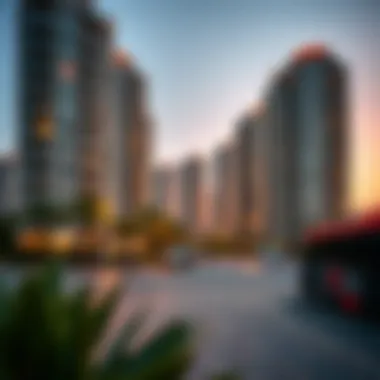

"Public transport should be a backbone of urban mobility; it should integrate seamlessly into every corner of the city.”
Service Reliability Issues
Service reliability is another significant concern for users of the 64 Bus Route. Passengers frequently report inconsistent schedules and delays which can throw a wrench into planned commutes. There are days when catches can be made, but there are also those when buses are delayed significantly, leading to frustration among commuters.
Local news outlets have also highlighted incidents where buses have run well behind schedule, causing a ripple effect on the overall transit experience. A few notable points regarding service reliability include:
- Variable travel times: Commuters may find that even during peak hours, buses can arrive haphazardly. What should be a reliable mode of transport can sometimes resemble a game of hit-or-miss.
- Limited real-time information: For a system that is fast emerging, real-time updates on bus arrivals can still be a few steps behind. Many users rely on mobile applications, but these can often lag or provide outdated information.
These reliability issues can deter potential users from utilizing the bus route, especially those who have tight schedules or need to adhere to consistent timings in their daily lives. Addressing these challenges directly can foster a better user experience and create a more effective public transportation network for Dubai's residents and visitors.
Future Developments for the Bus Route
As urban landscapes evolve, public transportation must keep pace to address the changing needs of its users. This imperative is especially pertinent to the 64 bus route in Dubai. The potential for future developments not only forecasts a brighter operational horizon for the bus service but also reflects wider trends in urban planning and transit integration. What is at stake is more than just improved convenience; it holds significance for sustainability, investment opportunities, and the overall quality of life for daily commuters and residents alike.
Potential Extensions and Upgrades
The journey of the 64 bus route does not stop at its current endpoint; instead, it paves the way for potential extensions. As Dubai continues to expand, the need for more accessible transportation options is undeniable. Future extensions could link the 64 route to emerging neighborhoods, which would create a direct impact on property values and commercial viability.
- New Stops: Additional stops might be established at key points of interest, such as shopping malls, educational institutions, or healthcare facilities—areas that attract foot traffic.
- Enhanced Routes: Upgrading existing infrastructure, such as introducing dedicated bus lanes, could lead to significant improvements in travel times. This would make the journey not just quicker but perhaps even more enjoyable.
- New Technology: The integration of smart technology for scheduling and real-time updates can enhance user experience. Imagine a scenario where a commuter is about to step out, only to receive a notification on the app that their bus is just a few minutes away.
Investing in such upgrades presents a fertile ground for developers and urban planners, given that convenience tends to attract residents and businesses.
Integration with Future Transport Projects
The vision for the 64 bus route does not exist in isolation. It must intertwine with broader transportation projects within the city, such as the expansion of the Dubai Metro and the introduction of high-speed rail lines. By participating in a cohesive urban mobility strategy, the bus route can benefit immensely, creating an integrated transport ecosystem.
- Seamless Connections: Ensuring that bus stops are located near metro and tram stations can enhance the overall efficiency of commuting. This seamless integration encourages the use of public transport, potentially lowering the number of vehicles on the road and alleviating traffic jams.
- Intermodal Stations: Planning for future intermodal transport hubs could provide a space where commuters can effortlessly transition from one mode of transport to another. Picture a central station where a person can switch from Metro to bus without navigating complex paths.
- Sustainability Initiatives: With the world leaning towards greener alternatives, aligning the 64 bus route with future eco-friendly projects could serve a dual purpose: reducing carbon footprints and appealing to environmentally conscious residents and investors.
Overall, the importance of these future developments cannot be underestimated. The 64 bus route stands to benefit immensely, offering opportunities for enhanced service, infrastructure improvement, and broader connectivity within Dubai’s vibrant urban landscape.
User Experience: Riding the Bus
Understanding the user experience of riding the 64 bus is crucial to grasp its role in Dubai's transportation ecosystem. The comfort and usability of public transport can greatly influence a commuter's decision to choose it over other modes of travel. Several factors contribute to the overall experience, from accessibility features to the measures taken to ensure passenger safety.
Accessibility Features
Accessibility is a significant aspect of public transportation, particularly in a diverse city like Dubai, where the population includes individuals with various needs. The 64 bus route does not skimp on providing accessibility options.
- Low-Floor Buses: Many buses on this route are designed with low floors that make it easier for passengers with mobility challenges to board and disembark.
- Designated Spaces: Each bus includes special areas specifically designated for wheelchairs and strollers, ensuring enough room for all passengers.
- Visual and Audio Aids: The 64 bus is equipped with technology that helps passengers with vision or hearing impairments. For instance, stop announcements are made audibly while also displayed on screens, making it clear for everyone where the bus is stopping next.
Overall, these efforts show that the Dubai public transport system is committed to inclusivity and aim to make every ride as pleasant as possible.
Safety Measures Implemented
Safety is another cornerstone of the user experience on the 64 bus route. Measures have been implemented not just for the passengers' peace of mind, but also to foster a secure environment.
- CCTV Surveillance: All buses are monitored by security cameras, which helps deter crime and ensures incidents can be reviewed if needed.
- Driver Training: Bus drivers receive rigorous training in safety protocols, focusing on not just the mechanical operation of the bus but also on effectively managing unexpected situations.
- Emergency Procedures: Passengers are informed about emergency exits and procedures, creating heightened awareness and preparedness among riders.
In summary, the attention to accessibility and safety on the 64 bus route reflects the commitment of Dubai’s public transport system to provide a positive commuting experience.
This enhanced user experience holds value not just for current passengers, but also for potential investors and developers who recognize that efficient and user-friendly public transportation can lead to increased property value and community interest. The importance of a reliable and enjoyable commuting option cannot be overstated in urban planning and development.
Ending: The Importance of the Bus Route in Dubai
The 64 bus route plays a crucial role in the public transportation landscape of Dubai. In a city known for its rapid growth and popularity among expatriates and tourists, this bus route provides a vital link among various neighborhoods and commercial areas. The significance of this route cannot be overstated, as it leads to increased accessibility and connectivity, ensuring that all residents can conveniently navigate the city's vibrant districts.
Summary of Key Points
Several key elements highlight the importance of the 64 bus route:
- Accessibility: The bus stops are strategically placed, allowing residents easy access to essential services, shopping centers, and cultural sites.
- Economic Impact: The route not only serves locals and tourists but also supports nearby businesses by increasing foot traffic, thus boosting local economies.
- Real Estate Implications: Properties located near this bus route can experience higher demand, translating to increased property values and investment opportunities.
- Environmental Benefits: Offering an eco-friendly transport alternative, the bus route encourages less reliance on personal vehicles, thus reducing traffic congestion and pollution in the city.
The strategic development of public transport routes, like the 64 bus, plays a pivotal role in shaping urban landscapes and fostering sustainable growth.
Implications for Future Urban Planning
As Dubai continues to grow, the importance of integrated public transit systems, such as the 64 bus route, will become even more apparent. Urban planners and developers should consider several factors:
- Expansion and Optimization: Future developments may include extending the bus route or enhancing service frequency to accommodate increasing population densities in emerging neighborhoods.
- Sustainability Initiatives: Integrating green technology and energy-efficient buses can reduce the carbon footprint further, aligning with the city’s sustainability goals.
- Smart Mobility Solutions: Embracing technological advancements in tracking and scheduling can improve the efficiency of bus services, attracting more riders and justifying further investments in infrastructure.
- Community Engagement: Gathering feedback from residents about their experiences and needs can shape future enhancements of the 64 bus route, ensuring it serves the community effectively.
In summary, the 64 bus route is more than just a means of transportation; it is a fundamental component of Dubai's urban infrastructure. Its influence extends beyond mere commuting, impacting economic activities, real estate trends, and environmental considerations. As such, it holds undeniable importance in shaping the future of urban living in Dubai.








